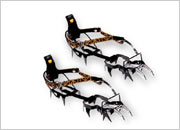
|
|
Crampons
These metal devices studded with two-inch spikes attach to a
climber's boots with a binding similar to those found on skis
and a thin ankle strap called a "keeper." A crampon's front
points are essential for vertical climbing, while the bottom
points are useful for walking on ice, either vertically or on
level ground.
|
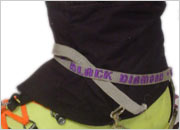
|
|
Gaiters
Usually made of nylon, gaiters are thick fabric sheaths that
cover a climber's legs from below the knee to his or her
ankle. They help prevent climbing pants from snagging and
ripping on gear and ice, and they keep snow from getting into
boots and pants.
|

|
|
Helmet
An ice climber's helmet works by absorbing energy applied to
it, such as that from the impact from a fall or a chunk of ice
dropping from above, in order to protect his or her head. The
helmet's hard outer shell is made of fiberglass and has a
lining of form-fitting foam. At night or in low-light
situations, ice climbers wear headlamps on their helmets.
|

|
|
Runners
Runners are short pieces of strong nylon webbing that climbers
use with carabiners (metal clips) to attach their ropes to
special screws driven into the ice and to make other
connections along a route. Jamie might carry 12 of these loose
runners on his harness. During a climb, they remain within
easy reach.
|
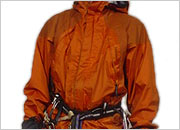
|
|
Jacket
There is no one kind of jacket specific to ice climbing, but
this element of a climber's equipment should be warm,
breathable, waterproof, lightweight, and relatively
formfitting. A bright-colored jacket like Jamie's can help
others see a climber from afar.
|
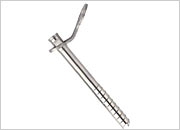
|
|
Ice screw
Climbers screw these hollow steel tubes with sharp, pointed
ends into ice. The threads on the cylinders' exteriors hold
the screws in place tightly enough to support hundreds of
pounds of force. A climber then clips his or her rope into the
screws, which are placed at frequent intervals along a route,
allowing for safe movement across the ice. If the climber
slips, the screw anchors the rope to prevent a fall.
|
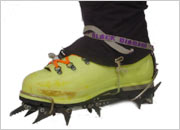
|
|
Boots
These plastic, two-piece boots made with separate fabric
liners are typical of most ice-climbing boots. They have a
rigid steel shank and bottom platform, which provide support
to ankle and foot. Jamie's boots are similar to downhill ski
boots, but they are not difficult to walk in. Plastic boots
are warm enough for ice climbing in even the coldest climates,
such as that found in Antarctica.
|
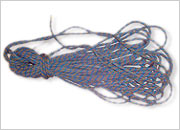
|
|
Rope
The so-called kern/mantle rope ice climbers use has a dual
nylon construction. The plaited outer mantle provides a smooth
surface for tying knots and lessening drag. It moves freely
through a climber's hands and shields the kern, or inner core,
from damage. The kern, made of multiple parallel bundles of
nylon, stretches, much like a bungee cord, to absorb a fall.
|
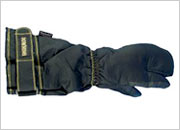
|
|
Gloves
Many ice climbers wear "lobster claw" gloves like Jamie's,
which are mittens in which the index finger as well as the
thumb are free as in a glove. Without compromising the warmth
of a mitten, these gloves allow for more dexterity, necessary
for grabbing ropes and grasping tools. Jamie's gloves are
waterproof and fleece-lined, and have extra foam padding on
the knuckles for protection.
|
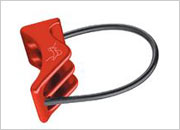
|
|
Belay device
This piece of gear uses friction to hold a climber in place on
a rope. A climber's rope feeds through the metal belay device,
which attaches to the harness of the climber's partner. Using
hand movements, the partner, or belayer, can control the rope,
offering slack when the climber ascends and locking it off if
he or she should fall.
|
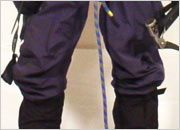
|
|
Pants
Jamie's pants are typical of what most ice climbers wear. They
are waterproof and windproof, but they are light enough to
allow for movement and layering of thermal clothing
underneath. Zippers on the sides of Jamie's pants allow him to
remove them without taking his boots off.
|
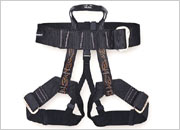
|
|
Harness
An ice-climber's nylon harness provides a place to securely
attach his or her rope. It also serves as the gear "hub"
during a climb, as every technical item must be readily
available at all times. Harnesses are made with gear loops
onto which a climber may attach carabiners, ice screws, and
other gear. The harness consists of a waist belt and two leg
bands, which help distribute force evenly across the thighs,
hips, and lower back.
|

|
|
Ice axe
Metal ice axes allow climbers to indirectly grip the ice with
their hands. While climbing, they usually carry one in each
hand. The head of the tool features a pick on one side and
either an adze (a flat chisel-like device used for chopping
holes in ice) or a hammer on the other. Typically, a climber
will use the pick to grasp ice while moving, the adze to clear
away ice before placing screws, and the hammer to pound them
in, if necessary. The shaft of the axe is rubberized for easy
gripping.
|

